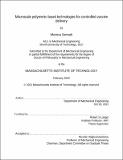| dc.description.abstract | Outbreak of infectious diseases such as COIVD-19 is one of the most critical challenges threatening global health and economy, particularly in developing world. Technologies that can improve delivery, access, effectiveness, and stability of vaccination, as a promising tool against outbreaks, would be strategic tools to potentially save lives and avoid trillions of dollars in financial losses. Our group has been developing such platform technologies for controlled delivery and tracking of vaccines. This thesis investigates further development of these technologies toward clinical translation. In the first part, we investigate a locally injectable microparticle system with a core-shell microstructure made from a novel 3D printing process compatible with biodegradable polymers. These microparticles can be used for delayed, pulsatile release of vaccines, therefore reducing the number of administrations to a single one. We study two translational aspects of core-shell microparticles, namely, injectability, and mechanism of pulsatile release. To study injectability, we use a wide range of tools, namely, multiphysics simulation, experiments, machine learning, and 3D printing to establish a framework for optimal injection of microparticle-based drugs. To study the mechanism of pulsatile release, we integrate various experimental tools with multiphysics simulations to form a model describing the mechanism of degradation and pulsatile release from core-shell particles. In the next phase of this thesis we move forward to a transdermal dissolvable microneedle patch without the need for injections. These microneedle patches can be used to track medical record on patient without the need for expensive healthcare infrastructure--a challenge in developing world. Using extensive computational modeling, we establish a design framework for microneedle devices, widely applicable to any microneedle system. Best trade-off design is then selected for administrations in vivo. We further develop a machine learning algorithm coupled with image processing tools to provide long-term pattern classification capability for encoding information transferred by microneedles to the patient, in an automated and robust fashion. Results of this thesis could be of great interest to development of next generation biomedical devices for controlled vaccine delivery and other applications. | |
